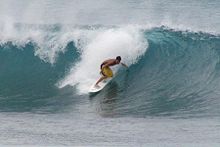Surf break

A surf break (also break, shore break, or big wave break[1]) is a permanent obstruction such as a coral reef, rock, shoal, or headland that causes a wave to break,[2] forming a barreling wave or other wave that can be surfed, before it eventually collapses. The topography of the seabed determines the shape of the wave and type of break. Since shoals can change size and location, affecting the break, it takes commitment and skill to find good breaks. Some surf breaks are quite dangerous, since the surfer can collide with a reef or rocks below the water. Surf breaks are often defended vehemently by surfers. In 2008, surfers and environmentalists opposed a road project in Del Mar, California that would have changed sediment patterns and affected the world-class Trestles surf break at San Onofre State Beach which attracted 400,000 surfers in 2007.[3]
In 2007, the NSW Geographical Names Register began formally recognizing names of surf breaks in Australia, defining a surf break as a "permanent obstruction such as a reef, headland, bombora, rock or sandbar, which causes waves to break".[2]
One of the largest surf breaks in the world is the Jaws surf break in Maui, Hawaii, with waves that reach a maximum height of 40–60 feet (12–18 m).[4]
Types of breaks
There are several types of breaks.
Point break
A point break refers to the place where waves hit a point land or rocks jutting out from the coastline. Bells Beach in Australia and Jardim do Mar in Madeira, Portugal are examples of point breaks.
Beach break
A beach break takes place where waves break on a sandy seabed. An example of a classic beach break is Hossegor in Southern France, which is famous for barrels of up to 20 feet (6.1 m).
Reef break
A reef break happens when a wave breaks over a coral reef or a rocky seabed. These waves are perhaps the most dangerous if a surfer wipes out badly. Example are Cloudbreak in Fiji and Jaws in Maui.
See also
References
- ^ Turner, Sarah (2006-02-05). "The best surf break". The Guardian. Retrieved 2009-04-02.
Above all, it's a quality wave, it's reliable, it's a classic big wave break
- ^ a b Silmalis, Linda (2007-04-08). "Surf break names recognised". The Daily Telegraph. Retrieved 2009-04-02.
THE tradition within the surfing community of naming the local break is set to be recognised with the NSW Government to create a formal register
- ^ Flaccus, Gillian (2008-02-07). "Officials Pick Surf Break Over Toll Road - Local News". Fox News. Retrieved 2009-04-02.
Surfers and environmentalists threw a roadblock in front of a proposed toll road through one of the world's best surf breaks
- ^ Hurley, Timothy (2002-11-18). "Maui's monster surf break getting bigger by the day". Retrieved 2009-04-02.
Jaws — or Pe'ahi, as many locals call it — offers some of the largest surfable waves on earth. About a dozen times each winter, wave faces reach 40 to 60 feet and more from trough to peak, taller than a four- to five-story building
